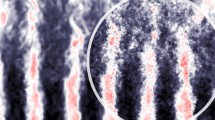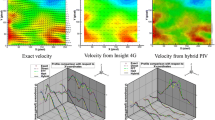Abstract
This paper proposes a dual calculation method (DCM) that in velocity fields obtained from particle tracking velocimetry detects spurious velocity vectors. The synthetic images were used to test the performance of the DCM. By adding random erasing to the genuine matching data, the influence of noise effect was simulated and analyzed. A comparison with the minimum net-flux method indicates that the DCM is more effective in identifying erroneous vectors as particles having no genuine candidates are more readily identified, thereby, ensuring strong consistent match. The DCM is also found to be more effective in addressing particle saltation, based on the accurately abstracted trajectories, the kinetic parameters of the sand grains are calculated.
Graphical Abstract

.









Similar content being viewed by others
References
Adrian RJ (2005) Twenty years of particle image velocimetry. Exp Fluid 39(2):159–169
Andreotti B, Claudin P, Douady S (2002) Selection of dune shapes and velocities—Part 1: dynamics of sand, wind and barchans. Eur Phy J B 28(3):321–339
Baek SJ, Lee SJ (1996) A new two-frame particle tracking algorithm using match probability. Exp Fluid 22(1):23–32
Baek SJ, Lee SJ (1998) Development of 2-frame PTV systems and its application in a channel flow. Trans KSME 22(6):874–887 (In Korean)
Bagnold RA (1954) The physics of blown sand and desert dunes. Dover Publications Inc, New York
Barnard ST, Thompson WB (1980) DISPARITY ANALYSIS OF IMAGES. IEEE Trans Pattern Anal Mach Intell 2(4):333–340
Brevis W, Nino Y, Jirka GH (2011) Integrating cross-correlation and relaxation algorithms for particle tracking velocimetry. Exp Fluid 50(1):135–147. doi:10.1007/s00348-010-0907-z
Cardwell ND, Vlachos PP, Thole KA (2011) A multi-parametric particle-pairing algorithm for particle tracking in single and multiphase flows. Meas Sci Technol 22(10). doi:10.1088/0957-0233/22/10/105406
Doh DH, Kim DH, Cho KR, Cho YB, Lee WJ, Saga T, Kobayashi T (2002) Development of genetic algorithm based 3D-PTV technique. J Vis 5(3):243–254
Hartmann J, Kohler J, Stolz W, Flogel H (1996) Evaluation of unsteady flow fields using cross-correlation in image sequences. Exp Fluid 20:210–217
Hassan YA, Canaan RE (1991) full-field bubbly flow velocity-measurements using a multiframe particle tracking technique. Exp Fluid 12(1–2):49–60
Liang DF, Jiang CB, Li YL (2003) Cellular neural network to detect spurious vectors in PIV data. Exp Fluid 34(1):52–62. doi:10.1007/s00348-002-0530-8
Mikheev AV, Zubtsov VM (2008) Enhanced particle-tracking velocimetry (EPTV) with a combined two-component pair-matching algorithm. Measurement Science & Technology 19 (8)
Nalpanis P, Hunt JCR, Barrett CF (1993) Saltating particles over flat beds. J Fluid Mech 251:661–685. doi:10.1017/s0022112093003568
Ohmi K, Li HY (2000) Particle-tracking velocimetry with new algorithm. Meas Sci Technol 11(6):603–616. doi:10.1088/0957-0233/11/6/303
Ohmi K, Panday SP (2009) Particle tracking velocimetry using the genetic algorithm. J Vis 12(3):217–232
Ohmi K, Panday SP, Sapkota A (2010) Particle tracking velocimetry with an ant colony optimization algorithm. Exp Fluids 48(4):589–605. doi:10.1007/s00348-009-0815-2
Okamoto K, Nishio S, Saga T, Kobayashi T (2000a) Evaluation of the 3D-PIV standard images (PIV-STD project). J Vis 3(2):115–124
Okamoto K, Nishio S, Saga T, Kobayashi T (2000b) Standard images for particle-image velocimetry. Meas Sci Technol 11(6):685–691
Pereira F, Stuer H, Graff EC, Gharib M (2006) Two-frame 3D particle tracking. Meas Sci Technol 17(7):1680–1692. doi:10.1088/0957-0233/17/7/006
Raffel ME, WC T, WS JK (2007) Particle image velocimetry: a practical guide. Springer, Berlin
Ruhnau P, Guetter C, Putze T, Schnorr C (2005) A variational approach for particle tracking velocimetry. Meas Sci Technol 16(7):1449–1458
Saffman PG (1965) The lift on a small sphere in a slow shear flow. J Fluid Mech 6:16
Sheng J, Meng H (1998) A genetic algorithm particle pairing technique for 3D velocity field extraction in holographic particle image velocimetry. Exp Fluids 25(5–6):461–473
Song X, Yamamoto F, Iguchi M, Murai Y (1999) A new tracking algorithm of PIV and removal of spurious vectors using delaunay tessellation. Exp Fluids 26(4):371–380
Sun JH, Yates DA, Winterbone DE (1996) Measurement of the flow field in a diesel engine combustion chamber after combustion by cross-correlation of high-speed photographs. Exp Fluid 20(5):335–345
Uemura T, Yamamoto F, Ohmi K (1989) A high-speed algorithm of image analysis for real time measurement of a two-dimensional velocity distribution. Flow Visualization ASME FED 85:129–134
Wang D, Wang Y, Yang B, Zhang W (2008) Statistical analysis of sand grain/bed collision process recorded by high-speed digital camera. Sedimentology 55(2):461–470
Wang Y, Wang D, Wang L, Zhang Y (2009) Measurement of sand creep on a flat sand bed using a high-speed digital camera. Sedimentology 56(6):1705–1712
Waston DF (1981) Computing the n-dimensional delaunay tessellation with application to Voronoi polytopes. Comput J 24(2):167–172
Westerweel J (1994) Efficient detection of spurious vectors in particle image velocimetry data. Exp Fluid 16(3–4):236–247
White BR, Schulz JC (1977) Magnus effect in saltation. J Fluid Mech 81(JUL13):497–512
Willert CE, Gharib M (1991) Digital particle image velocimetry. Exp Fluids 10(4):181–193
Willetts BB, Rice MA (1986) Collisions in aeolian saltation. Acta Mech 63(1–4):255–265
Zhang W, Kang J-H, Lee S-J (2007) Tracking of saltating sand trajectories over a flat surface embedded in an atmospheric boundary layer. Geomorphology 86(3–4):320–331
Zhang W, Wang Y, Lee SJ (2008) Simultaneous PIV and PTV measurements of wind and sand particle velocities. Exp Fluids 45(2):241–256
Acknowledgments
The support provided by the National Natural Science Foundation of China (NSFC 11272252, 11022153) is gratefully acknowledged. We also thank Professor Kazuo Ohmi, Osaka Sangyo University, Japan.
Author information
Authors and Affiliations
Corresponding author
Rights and permissions
About this article
Cite this article
Jia, P., Wang, Y., Zhang, Y. et al. Relaxation algorithm-based PTV with dual calculation method and its application in addressing particle saltation. J Vis 18, 71–81 (2015). https://doi.org/10.1007/s12650-014-0228-z
Received:
Revised:
Accepted:
Published:
Issue Date:
DOI: https://doi.org/10.1007/s12650-014-0228-z




